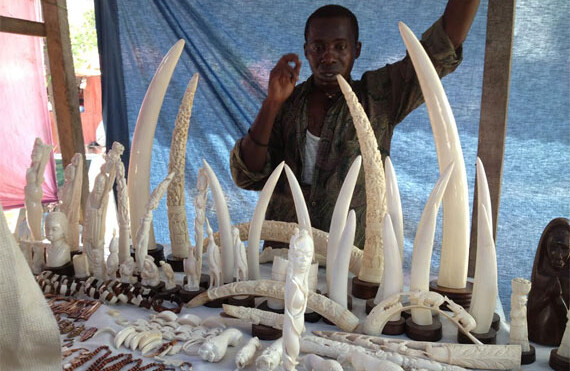Conservationists need a unified approach to stop the illegal trade in wildlife products: species protection, human development, good governance, and enforcement.
In a recent article, "Prince William will need new ideas to tackle wildlife crisis," Oxford University conservationist Paul Jepson critiques the London Conference on the Illegal Wildlife Trade, hosted in February 2014 by the UK Government and the Prince of Wales. Jepson's narrative deserves comment due to some misconceptions he puts forth, including confusion over the intent and substance of the London Conference and of a related but separate scientific meeting that was hosted by the Zoological Society of London the same week, the United for Wildlife (UfW) International Wildlife Trafficking Symposium.
Jepson considers the Conference a less ambitious shadow of the 1933 London Conference on African Wildlife, which inspired the formation of national parks and nature reserves. This comparison is inappropriate given that February's meetings focused not on broad approaches to wildlife conservation but more on the specific threats that trafficking poses to commercially valuable species (especially elephants, rhinos, and tigers). He makes the comparison partly to draw attention to the need to address local livelihoods and sustainable use, wildlife farming, and the idea of legal trade in certain species.
Jepson then draws a dichotomy between this approach of promoting use and trade, and what he sees as the more regulatory approach adopted by the 2014 London Conference, which called for reducing demand for wildlife products, ensuring effective legal frameworks, and strengthening law enforcement. Once that dichotomy is drawn, Jepson reverts to a condemnation of prohibition-based approaches to conservation, and a reiteration of the call for sustainable use, community-based approaches, and promotion of legalized trade.
This tired repetition of an old dichotomy misses the point. High-value wildlife products, such as elephant ivory and rhino horn, are now traded transnationally by capitalized criminal syndicates, facilitated by corruption at many levels. In this context, strengthening regulation and enforcement by national authorities is essential in protecting local rights and resources. Organized criminal activities, and the corruption that underlies them, undermine local livelihoods and reduce opportunities for sustainable use.
As the World Bank's biodiversity specialist Valerie Hickey puts it:
Wildlife crime is leading to the proliferation of guns in exactly those areas that need less conflict, not more; it is providing money for corruption, in exactly those countries in which corruption has already stalled all pro-poor decision-making and doing business legitimately is already hard enough; and it is oiling the engine of crime and polluting efforts at good governance, democracy and transparency in exactly those communities that need more voice, not more silence. It is anti-worker, anti-women and anti-poor.
While Rosaleen Duffy, author of Nature Crime, who (like Jepson) is worried about calls for a tougher stance to combat poaching and wildlife trafficking, writes:
I asked the panelists whether they were concerned that a militarized approach might undermine the gains from Community Based Natural Resource Management (CBNRM). I got an interesting answer that made me sit back and pause for thought, too: We need to persuade communities that these poachers are robbers, robbing them of their property and making them poorer.
The UfW Symposium urged that the root causes of organized wildlife trafficking (corruption, poor governance, increasing demand) be analyzed and addressed strategically. Both the UfW action plan (summarized here) and the London Conference Declaration emphasized the need to protect wildlife populations and support the development of sustainable livelihoods for communities. Many participants, speakers, and organizations at the Symposium, and governments attending the Conference, strongly support well managed, science-based sustainable use. However, these approaches will only work to benefit wildlife and local communities when accompanied by good governance and the rule of law—necessary corollaries of addressing the illegal wildlife trade.
Jepson nevertheless remains skeptical of prohibition-based approaches to conservation, and draws attention to the failure of the "war on drugs." The analogy, however, is weak. Ivory, rhino horn, and other wildlife products are not addictive; there is much higher global demand for drugs than there is for these wildlife products; and people across the world want drugs, but the main markets for ivory, rhino horn, tiger parts, and pangolins are in only a handful of countries, primarily in the Far East.
Thus, the "war on the illegal wildlife trade" is a smaller endeavor. Victories can be and have been won. Demand for rhino horn, for example, in Japan, South Korea, Taiwan (Republic of China), and Yemen, once major consumers, has been significantly reduced through a combination of demand reduction campaigns, import bans, moratoria on domestic sales, and threats and subsequent imposition of sanctions by the United States under the Pelly Amendment.
Jepson's use of the "war on drugs" analogy, of course, stigmatizes wildlife law enforcement. The Conference was sensitive to this issue, and recognized the pressing need for the equitable, transparent, and humane functioning of law enforcement and the judiciary, as well as broader issues of sound democratic governance. Combating the illegal trade in wildlife must not become an excuse to lock up poor people or people that governments find politically problematic. Implementing safeguards to prevent this is especially important in countries where legal protections and the institutions for ensuring their application are weak, and human rights records are poor.
Jepson would prefer to encourage trade in wildlife products, not discourage it:
Market-based approaches to governing supply-chains (for example FSC forest certification and crocodile farming) have been around for 20 years and subjected to detailed academic and policy scrutiny. South Africa and other African countries promoting sustainable use have made a compelling case, based on experience, for a legal trade in rhino horn, and have cautioned against mass destruction of ivory stocks.
Unfortunately, he fails to note any of the significant challenges inherent to a legal trade in high-value wildlife products. Demand for ivory and rhino horn is burgeoning, driven largely by China and Vietnam, respectively, but the effect of creating even a well-regulated legal trade on demand is uncertain at best. Parallel legal and illegal markets would be created which would facilitate the "laundering" of illegal ivory and rhino horn into legal markets.
The situation would be exacerbated by poor governance and lack of enforcement of domestic and international laws in many countries of origin, transit, and consumption. There are also major challenges posed by the large and increasing role now played by organized crime syndicates in the illegal wildlife trade. Furthermore, there is a lack of human and financial resources commensurate with the scale of the problem in many regions.

Poached elephant carcasses in Zakouma National Park, Chad. CREDIT: Darren Potgieter © WCS.
Increasingly, too, there is recognition of the weakness of "simplistic" economic modeling that is often used to justify a legal trade in these high-value products. The fact that legal sustainable trade in crocodile leathers or timber can proceed, in well managed and enforced situations, in countries with a strong rule of law and good governance, does not make a prima facie case for similar trade in ivory or rhino horn (and indeed significant problems continue to affect both the crocodile leather industry and the timber trade).
This realization, coupled with ever-increasing awareness of the severity of the threats that illegal trafficking poses to elephants (see examples here, here, here, and here) and rhinos (examples here, here, and here) resulted in even pro–ivory-trade countries such as Tanzania and Botswana declaring—during the events in London—a moratorium on any international trade for a minimum of 10 years and thereafter until African elephant populations are no longer threatened, and agreeing to put all ivory stockpiles beyond economic use.
Finally, Jepson argues that there was an over-emphasis on the top-down techniques of "big government." Here he is preaching to the converted. At the Symposium, there was also significant discussion about the need for grassroots social media campaigns, the role of NGOs and academics, and the value of private sector engagement, while the Conference and resulting Declaration also highlighted the need to promote "innovative partnerships for conserving wildlife through shared management responsibilities such as community conservancies, public-private partnerships, sustainable tourism, revenue-sharing agreements and other income sources such as sustainable agriculture."
To conclude, Jepson calls for "a broader range of approaches, with which to approach the modern world's messy, networked, multi-polar nature." But by failing to appreciate either the specific focus on the illegal trade in ivory, rhino horn, pangolins, and Asian big cats, or the diversity of approaches that were actually discussed at these meetings, he creates an unhelpful false dichotomy that risks polarizing conservationists against each other unnecessarily.
If the goal of the UfW Symposium and the London Conference had been to address the multiple crises facing the world's wildlife then they would indeed have been a failure, but that was not the goal. The Symposium aimed "to review the lessons learned from existing efforts and harness skills from other applicable fields in order to better understand how to protect the supply and reduce the demand that drives the illegal trade," while the goal of the Conference was to identify how to strengthen law enforcement and the criminal justice system, reduce demand for illegal wildlife products, and support the development of sustainable livelihoods for communities affected by illegal wildlife trade.
Once one recognizes this context, it becomes clear that the meetings represented a significant step forward. Our energies should now be focused on working with governments, NGOs, and local communities to help see that the commitments made in London become reality.
Simon Hedges is Asian Elephant Coordinator and Ivory Trade Policy Analyst for the Wildlife Conservation Society. This article benefited greatly from extensive conversations with and insights from John Robinson, Michael Painter, Sue Lieberman, Liz Bennett, and Susan Canney.





